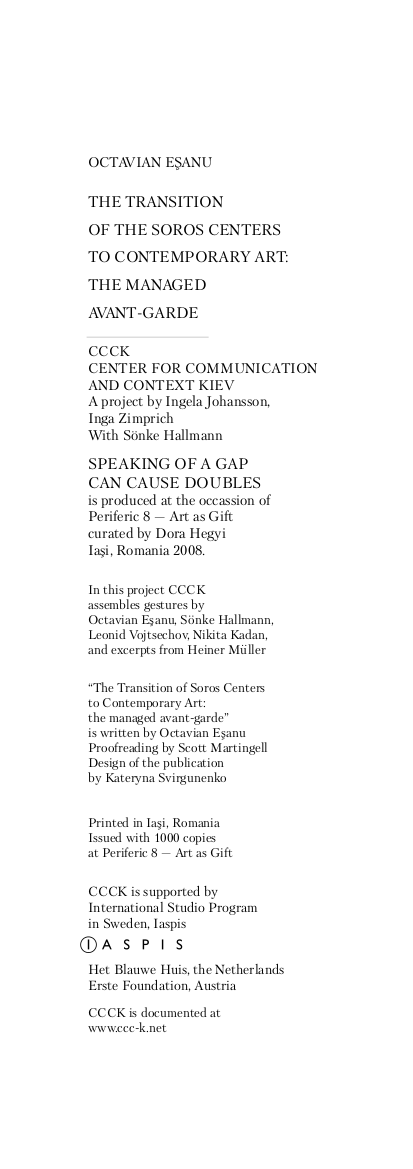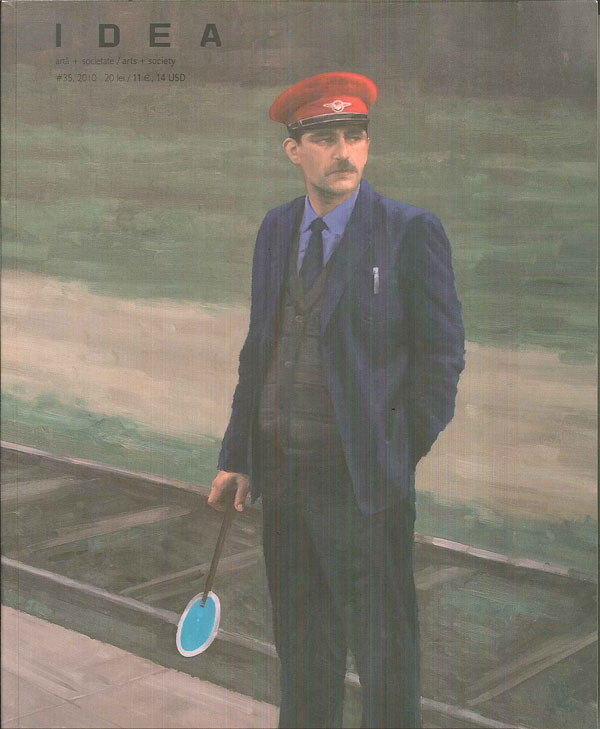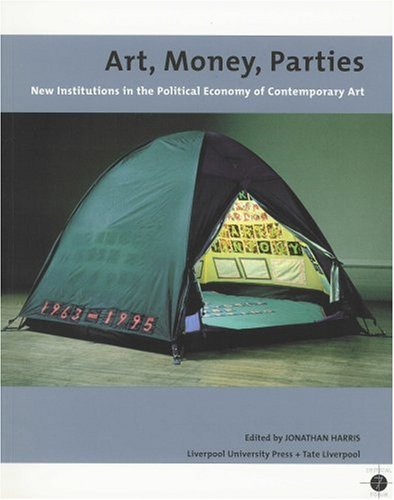Octavian Eşanu: The Transition of The Soros Centers to Contemporary Art: The Managed Avant-Garde (2008)
Filed under pamphlet | Tags: · art system, contemporary art, eastern europe, institutional critique

“As in other transitological regions of the world, in Eastern Europe, throughout the 1990s, this “neo-liberal discourse of radical reform” became a new ideology. It quickly installed itself in the vacuum left after the collapse of Marxism-Leninism, and its working postulates (directed primarily at politics and economics) soon reached into the domain of art and culture, altering not only pre-established artistic and aesthetic conventions but changing also the social status of art in the post-communist society. While in such fields as politics and economy this doctrine has been recognized and accepted from the very beginning as a legitimate discourse – prompting some scholars to call for “the end of the transition paradigm” – by contrast, in art no analysis has been done on the importance of the notion of “transition” and the impact of transitology. The effect of this paradigm on art, however, was significant. Many individual changes within art resemble the pattern of political and economic reforms to such a degree that one may infer the existence of a “cultural transitology” – a hidden managerial agenda that monitored and implemented reforms in the field of culture. One of the first points on this agenda was the transition to a Western artistic model, and this was one of the main tasks of the SCCAs. One can set a parallel and compare the role of the SCCA network with that played by such active participants in the process of transition as the International Monetary Fund (IMF) and the World Bank. While these international organizations have been concerned in such fields as economics and politics with various aspects of social transformation – disputing such issues as the conversion of planned economies into free markets, or the dissemination of liberal democratic values at the expense of other political doctrines – the SCCAs dealt mainly with the emancipation of art and culture from the ideological, political and economic control of the state. On the aesthetic level this transition was manifested in the attempt to break with the doctrine of Socialist Realism, with its aesthetic and ideological principles; artists were encouraged to work with new media whereas art historians were to write new art histories, which would evolve around the narrative of the formerly suppressed non-conformism. Economically the SCCAs provided expertise for developing local networks of Western styled private and corporate art institutions capable of accommodating to the logic of the free market. After escaping the ideological and material control of the state the centers were to help local artists adjust to a new order, devoting a good part of their efforts to cultural management and fund raising.” (excerpt)
Published by CCCK, Kyiv, at Periferic 8 “Art as Gift” Biennial for Contemporary Art in Iaşi, Romania
20 pages
PDF, PDF (updated on 2019-10-22)
Comment (0)IDEA Arts + Society (2003–) [Romanian/English]
Filed under magazine | Tags: · activism, art, art criticism, art theory, autonomy, capitalism, contemporary art, cultural criticism, eastern europe, institutional critique, performance art, politics, romania, society, southeastern europe, theory, video art

Idea 36-37, 2010

Idea 35, 2010
“IDEA art+society is a multiannual publication produced by IDEA, Cluj. It is published under its current form since 2003.
Allegiance to the exigency of genuine theory – a theory which is, first of all, its own practice – this is the program of IDEA arts+society magazine. This means: the practice of the concerned eye, which can be rigorous solely through the unconditional solidarity with the concrete. It is a practice of thinking which is alien to any aestheticism, hostile to any institutionalized transcendence, immune to the biased fiction of ideological neutrality, and remote from the pernicious language of our contemporary culture of ‘experts.’ In brief, it is the practice of critical and defiant reflection, dramatically lacking in the intellectual-civic debates of present-day Romania.
The graphical and logical operator ‘+’ functions as the material figura of all these dimensions, to which we can add artistic education and the public influence of art. The various ways of deciphering this sign suggest the manifold articulations between the artistic and the social realm. That is, the political.”
IDEA artă + societate / IDEA arts + society
Editors: Bogdan Ghiu, Ciprian Mureșan, Timotei Nădășan (editor-in-chief), Alexandru Polgár, Adrian T. Sîrbu, Ovidiu Țichindeleanu, Raluca Voinea
ISSN 1583–8293
Jonathan Harris (ed.): Art, Money, Parties: New Institutions in the Political Economy of Contemporary Art (2004)
Filed under book | Tags: · art, art criticism, art history, art system, contemporary art, institutional critique

This collection of essays sets out to identify and examine the kinds of new institutions and social relations that have emerged and begun to shape the global organisation of contemporary visual art over the past twenty-five years. These institutions and relations, contributors argue, are not simply implicated in the exhibition of art – more than that, they have come to play significant roles in commissioning art production as well as mediating its reception in a number of different ways. Given this reorganisation, the set of concepts through which the ‘art world’ can be thought must be radically reviewed. Developments and transformations in, for example, patronage and managerial arrangements – on a global scale – have begun to outrun existing assumptions, categories and accounts. Terms such as ‘institution’, ‘means of production’ and ‘art world’ itself are invoked and critically scrutinised in all of the essays in this book. Some authors address these and other concepts within detailed empirical case studies, others by experimental application of novel theoretical premises.
This collection also includes discussion by those directly involved in the production and selling of contemporary art, reviewing the increasingly internationalised network now ordering contemporary art’s conditions of production, mediation and consumption. This book shows the complex interaction of the socio-political forces that bear on the art world as well as the tensions between those with different interests in art, raising vital questions about the changed relations between art, society and politics.
Publisher Liverpool University Press, 2004
Volume 7 of Tate Liverpool Critical Forum
ISBN 0853237395, 9780853237396
216 pages
PDF (no OCR; updated on 2012-7-18)
Comment (0)
